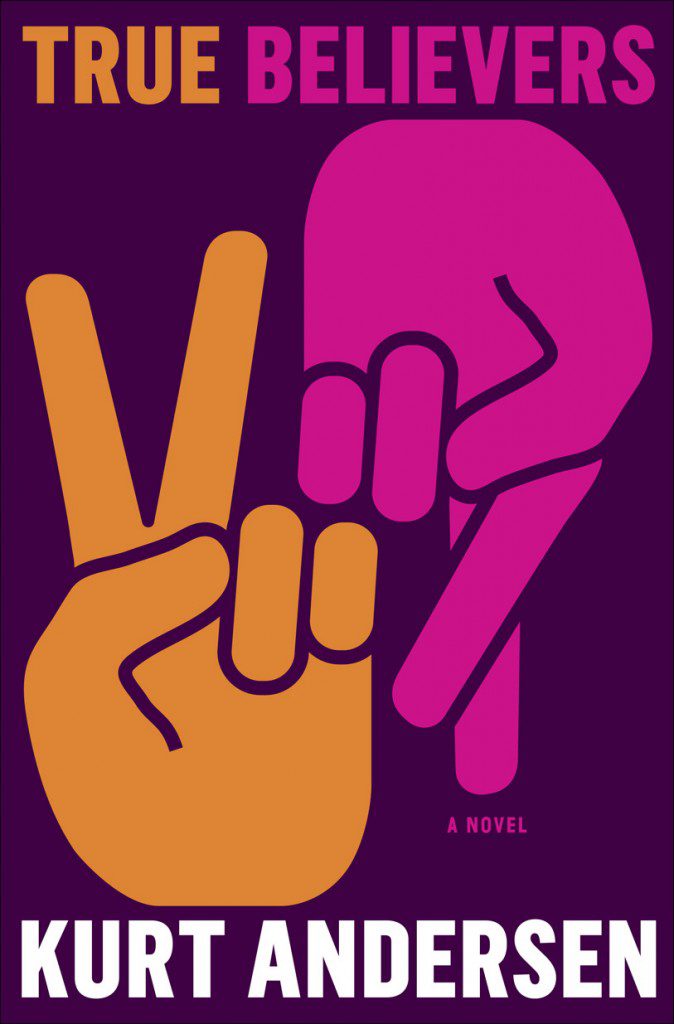 True Believers
True Believers
Kurt Andersen
Random House, 2012; 464pp
“My publishers signed me up a year ago to write a book, but not this book,” writes Karen Hollander at the start of Kurt Andersen‘s gripping True Believers. “Let me cut to the chase,” she goes on: “I once set out to commit a spectacular murder, and people died.” This “secret episode of 1960s berserkery and lost innocence” is the ostensible subject of Andersen’s novel and what gives it its compulsively thrillerish readability. Hollander, a famous lawyer and one-time Supreme Court shoo-in, was party to an act of radical violence in 1968 that has somehow remained a secret in the forty-six years since; as she reaches the end of her career, she feels compelled “to disinter the truth”, to let the sunshine in. But this is where Andersen’s secondary subject, which gives the book its philosophical heft, comes in: how structures of fantasy, the doubtfulness of memory, and the irreducible subjectivity of experience challenge, even efface, any stable notion of truth. Part satire, part social history, True Believers asks some big questions — what does it mean to be American? what role might utilitarianism play in political violence? — and reminds us that mania, however well motivated, is still madness.
Karen is a brilliant, complex, surprising central character. As a girl growing up outside Chicago, she’s a sort of Cassandra-with-clippings, a proto-Didion figure (though without the anxious paralysis), scrapbooking about Charles Starkweather’s killing spree, the Van Doren quiz-show scandal, the Bay of Pigs, the suicides of Hemingway and Plath. Her two great childhood friends, Chuck Levy and Alex Macallister, are boys who share her love of the novels of Ian Fleming. Together, they embark on a series of James Bond-inspired missions, assuming new identities, dressing like adults, speaking in European accents. But as the world around them becomes more and more like a Bond movie as the Sixties progress, elements of their childhood fantasies are allowed to germinate and linger on into their young adulthood. Later, Karen would identify her weakness for fiction — and for fictionalizing herself — as a tragic flaw, and one she seems unable to eschew. In the present day, working to piece together the events of 1968, she enlists the help of a shady government friend to help her access sealed records; the tenor of their interactions — from the use of unregistered cell phones to the staged meetings in public places — is every bit as Ian Fleming as her youthful spy games.
“Why I’m writing a book,” Karen states, “is to lay out something approaching the whole truth, with the thousand relevant dots in place, ready to be connected — some of the lines drawn by me, the overdetermining author and apologist, some by you, my jury of dispassionate strangers — and turned into a picture with the queer complications and shadings that make it a life.” Truth, as any lawyer knows, is the sort of word best trapped in air quotes, and Andersen does plenty to undermine Karen’s initial assertion that she is an “unusually reliable” narrator. Her diabetes leaves her open to accusations of hyperglycemic disorientation. Her daughter, Greta, a neuroscientist, is on hand to point out the inherent fallibility of memory, “especially in older people”. She’s frank about her narcotic intake. Nevertheless, Karen seems like an uncommonly perspicuous narrator: articulate, often aphoristic, and hyperconscious of her own cognitive biases (though what this apparent awareness might in turn be masking is up for debate). Through her, Andersen is able to explore “truth” in all its amorphousness and ambiguity, and in doing so, he lays out the inherent vice in his own title. What does it mean to believe something? Can something be true or only believed to be true?
The mania of the late sixties, what causes Karen and her friends to plan their act of radical violence, is one of the products of what she calls “a pandemic perceptual glitch”. For her generation — at least those infected with l’esprit de ’68 — the confluence of many different narratives, both personal and cultural, gives “the Movement” a demonic momentum. “The fact that puberty and the 1960s were kicking in at precisely the same moment was synergistic,” she writes: “each made the other seem more remarkable and important”. She has a cognitive preference, as did many in that period, for believing the worst; so it is that when listening to their African-American housekeeper, Violet, describe a lynching in Little Rock, Karen feels, “along with shock and disgust… excited to be getting the plain and ugly truth firsthand” (my emphasis). Karen and Chuck argue constantly with their parents about whether or not the US government can accurately be called “fascist”. For those who don’t remember the Second World War, the newsreel events of the 1960s — particularly its signature spate of assassinations — come to seem apocalyptic. By the start of 1968, Karen, Chuck and Alex are “feeling more and more as if America had gone mad and time was running out”.
Andersen goes to great lengths to establish the credibility of his plot, not least because its intersection with real events needs to be explained away if we are to suspend disbelief. But he goes to even greater lengths to establish the credibility of his heroine, to examine how a political radical whose adolescent plots could have changed the course of history might later devote herself to civic service and dispassionate justice. Karen’s sixty-five years, mostly spent in the execution of a successful legal career and the discharging of a purposefully boring marriage, has given her the perspective that her younger self lacked. Old Karen can see a thousand dots where young Karen saw only a handful. Where Philip Roth, working with similar material in American Pastoral, left a black hole where motive and rationality had been voided, Andersen seeks to provide an effective cosmology to explain it. Politics, cognitive bias, collective madness: all play their part. But some of it, Karen comes to believe, is also luck, existing “in some cosmic balance, like matter and antimatter”. Chance remarks and arguments, seemingly inconsequential actions, secrets that seemed secure — all return with the force of the repressed, ultimately proving instrumental in True Believers‘ tragic machine. The violence, when it comes, is not where the book appeared to be leading us. Tragedy terrifies because its signature irruption of horror is always built on a kind of devastating logic. Andersen’s construction here is impeccable.
Read the first chapter of True Believers here.
Kurt Andersen will appear at the 2016 Seriously Entertaining gala, I’ll Have Another, on February 1.




